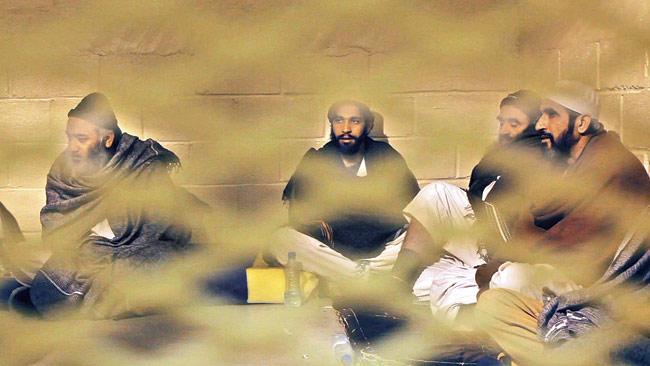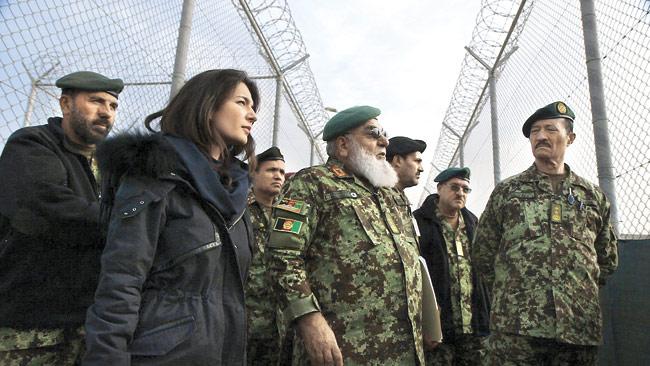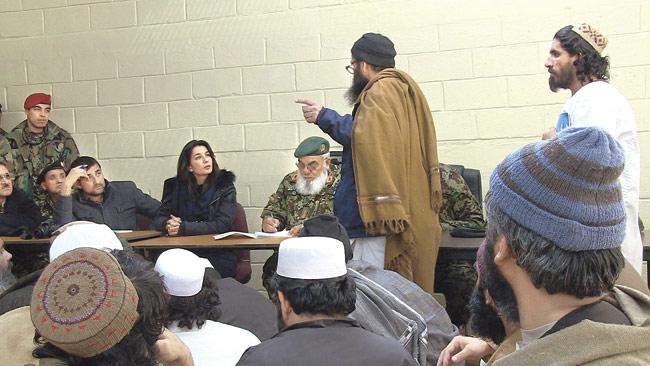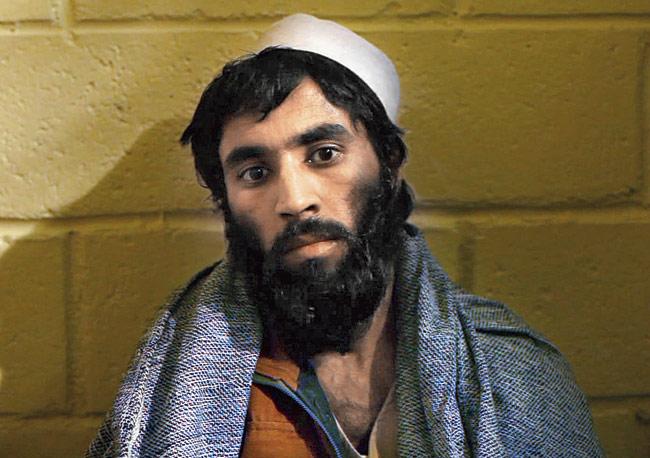This month, 65 detainees were released from a maximum detention facility in Afghanistan, defining a split between the US and Afghanistan. Tomorrow, BBC will air a programme on journalist Yalda Hakim’s journey behind the barbed wire, security fence, sniffer dogs and watch towers to look at life behind these bars that have thrown a shadow on the relationship between the allies

On Thursday, February 13 2014, the world learnt of a schism in US-Afghan relations when the gates of Afghanistan’s maximum security prison, Bagram, swung open and 65 detainees walked free.

A holding area for prisoners near the medical wing
ADVERTISEMENT
There was an ongoing protest and to date a debate simmers about whether these men are dangerous terrorists as the US states, or if they are innocent and illegally locked up by foreign soldiers, like the Afghan authorities state.

Yalda Hakim is shown around Bagram Prison by Afghan Army Commander, General Farooq Barakzai
The BBC World News presenter, Yalda Hakim, went to Bagram earlier this month. It is a new world inside the extensive perimeter security, including vehicle X-ray machines, sniffer dogs and machine gun nests, all under American control.

An Afghan detainee makes allegations of torture by US Forces to Yalda Hakim, during a meeting organised by prison authorities
Hakim says that it took two years of negotiations to get access to the prison and she arrived at the prison on a day when the Afghan Review Board (ARB), the committee responsible for the prisoner issue, had announced that it would be releasing 65 detainees.

Portrait of a detainee in Bagram prison
The ARB said these men could not be prosecuted because of a lack of evidence. The NATO-led international peacekeeping force (ISAF) quickly came out and condemned the decision, saying the detainees had “blood on their hands”.
Hakim says that she saw cell after cell of men who claimed to be farmers and innocents who got caught up in American raids. In many cases, views against America had crystallised to that of overwhelming hatred, she says.
Hakim says she met families there, come to meet their relatives in prison. “They were allowed about 30 minutes together, often separated by toughened glass. Each of the family members had numbered placards round their necks.”
In the end, Hakim says, “It is difficult to know whether these men are innocent or not. The Americans have accused the Afghan authorities of ignoring crucial forensic evidence.
Senator John McCain told me, “Many of these people were caught red handed. The tests on their fingers, of explosives on their hands. I mean, it’s not as if this was questionable. These are the hardcore of literally maybe over 1,000 that we have already released.”
The Interview:
When exactly did you go to Bagram, which days in particular?
I was in Bagram for two days in February.
How did you go to Bagram - fly from the UK to Afghanistan?
I travelled from London to Kabul. Bagram is on the outskirts of Kabul, about an 1.5 hour drive, or 65 kilometres, to be precise.
What were your first impressions about landing on Afghan soil?
I have travelled to Afghanistan a number of times to report - I am often surprised by how much has changed every time I am there. For example - there is more construction and there are more women on the streets.
What did you see at first on arriving at Bagram? From the limited pictures that the world has of these prisons there are high walls, barbed wire, watch towers...
It’s a maximum security prison, so high walls, barbed wire, watch towers, yes, they are all there - it is clinical, quite modern and well-equipped.
Was it unusual for the prisoners to see a woman entering the Bagram prison?
There are female soldiers in the US military; I don’t think, though, that they are used to seeing women walking around the prison.
How are the prisoners dressed - are they in orange like we have seen in pictures of other maximum security prisons?
They are not in orange, they have traditional Afghan dress on, which is provided to them at the prison.
How many of them are in Bagram?
At the time I was at the prison, I was told there were 1,343 detainees. I believe these were the Afghan detainees. The US still controls the wing in the prison where the non-Afghan-born prisoners are held.
Are they one to a cell - or many in one cell?
The cells I saw held many to a cell. I didn’t see anyone in solitary confinement.
Describe a cell in Bagram?
Everything is concrete, open plan, toilets and showers to one side, mattresses laid out on the floor. Very clean and clinical.
In what language did you speak to them?
I spoke to them in Dari, English and a little Pashto.
Did they have Afghan guards or American guards?
American soldiers man the security outside the prison, but the guards inside the prison walls were mainly Afghan.
While the prisoners would obviously say they are innocent, what do the authorities say in reaction to that?
The United States accuses the men of being dangerous terrorists and say they have American and Afghan “blood on their hands”.
They say the Afghan authorities are ignoring crucial forensic evidence. The Afghan authorities however say there is not enough evidence to prosecute them and that their American counterparts have failed to provide all the information to them, saying for example, names of sources have been redacted and for that “suspicion” is not enough of a reason to hold these men for years without trial. Some reports state that a lot of prisoners who are freed have gone back to terrorism. Last year, more than 500 men were freed.
It’s not clear whether their movements are monitored when they return to their provinces. What I found however is that whatever the truth maybe, innocent or guilty, after years of imprisonment, they’ve certainly developed anti- American sentiments.
Are there any women prisoners in Bagram?
No, there are no women in the prison.
How are they brought to Bagram where have they been detained?
The men I spoke to told me they were arrested during night raids conducted between US and Afghan forces. The majority of them are from the South of the country where Taliban hold sway and where US and Afghan troops conducted raids.
Did you meet their families who had come to meet them?
Yes, every day, families travel from across the country to see their incarcerated relatives. While I was there I was able to meet some of the families. I met the distressed mother of one of the prisoners, who said: “I feel very bad; because of all the worrying about him, we all are suffering from psychological problems now.
Is this life? His father, brother and sisters come to see him and we all leave crying. It is very difficult to see our son like this. There are lots of others like my son here. For god’s sake, they should think about them. We had only one court hearing in a year and a half!”
What about Afghanistan - did you meet local people, give me a little vignette about life there...
On this particular trip, I spent my most of my time in Bagram; however, I have been travelling back and forth to Afghanistan and reporting from there for a number of years. In that time, I have seen the country change, for the better.
In fact in just 12 years, I feel Afghanistan has managed to progress at quite a rapid rate. Of course, outside the cities, in the provinces, life remains grim. While security and terrorism are the biggest concerns for Afghans, high unemployment rates, poverty and a lack of education is also something that worries people.
All the world hears and sees are stereotypical images of fully covered women in Afghanistan; did you meet any working women etc there?
Life for many Afghan women remains dire. Forced marriages, abuse and torture are things they continue to face. However, I’ve spent a lot of time with young women at Kabul University for example who told me they have high hopes for the future.
As the next generation of Afghan women gain education and begin working in different fields, this could to help change perspectives both in the country and outside. Given their treatment under Taliban rule, they’ve come a long way. But there is still much to be done.
While they say they are innocent, some say they are terrorists - what did you learn from your visit there?
I was not there to determine whether these men were innocent or guilty. I wanted to understand what life was like in a maximum-security prison.
Cell after cell, men complained to me about being held without trial. I also wanted to investigate how the prisoner release issue had caused a toxic political row between Kabul and Washington. Prisons, I find, are depressing places. Seeing people shackled hand and foot is degrading - regardless of who they are and what their crime is.
 Subscribe today by clicking the link and stay updated with the latest news!" Click here!
Subscribe today by clicking the link and stay updated with the latest news!" Click here!







